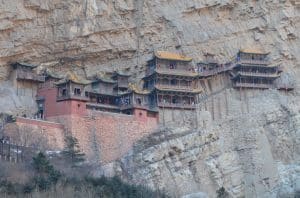Recently, the computer game “Black Myth: Wukong” has gained global popularity. However, did you know that in one of the game’s primary filming locations, Shanxi Province, many ancient buildings are under threat from climate change?
Shanxi, home to one of the largest collections of ancient architectural remains in China, is renowned for its well-preserved historical timeline, diverse architectural styles, and variety of forms. It is often referred to as the “Treasure House of Ancient Chinese Architecture.”
According to statistics from the third national cultural relics census, Shanxi is home to 53,875 immovable cultural relics, including 28,027 ancient buildings, with its iconic wooden structures being particularly famous.

Copyright @ CTrip
“Climate is the key factor in the preservation of ancient buildings”
An Hai, deputy director of the Shaanxi Provincial Institute for the Protection of Ancient Architecture and Painted Sculptures and Murals, told reporters. “The historically dry, low-rainfall climate and the absence of extreme weather have provided ideal conditions for the preservation of ancient wooden buildings.” In his view, climate has been the crucial factor behind the large number of ancient architectural remains that have survived in Shanxi to this day.
Located in the western part of the North China Plain, Shanxi has a temperate continental monsoon climate with low annual precipitation, and mostly concentrated in summer.
For instance, in Hunyuan County, Datong City-home to the Hanging Temple (悬空寺)-the annual average temperature is only 6.5℃, with an annual precipitation of around 407 mm, and an average relative humidity of less than 40%.
Similarly, in Ying County, Shuozhou City, where the Sakyamuni Pagoda of Fogong Temple (also known as the Yingxian Wooden Pagoda) is located, the climate is much the same, with – an annual average temperature of 7.1℃ and precipitation of aound 360 mm.
Under such climatic conditions, the wooden components of these ancient buildings are less prone to decay, allowing them to retain their original characteristics and structure.
The survival of Shanxi’s ancient buildings is not only due to the climate conditions but also the ancient craftsmen’s understanding and application of climate laws. An Hai attributes this to the adaptive designs of ancient builders.
For example, the Hanging Temple of Hengshan is built on a cliff within a valley. The valley winds, especially in the morning and evening, help regulate the surrounding temperature and humidity, while the peaks around the temple shield it from the scorching sun.
During summer, the temple receives less than three hours of direct sunlight each day. This stable environment of consistent temperature, humidity, and limited sunlight acts like a natural air conditioner for the temple..
In addition, the temple is suspended within a concave cliff wall that is 10 meters deep and over 40 meters long. The overhanging part of the cliff acts like an umbrella, protecting the temple from rain throughout the year, while the floods below never reach the structure.
As a result, the wooden components of the temple are minimally affected by natural erosion, allowing them to remain well-preserved.
“When designing buildings, ancient craftsmen would take into account the specific climate characteristics of different regions, such as southeastern Shanxi, southern Shanxi, and northern Shanxi,” An Hai explained. “For example, in areas with more rainfall, roofs would be built straighter and steeper to facilitate drainage; while in areas with less rainfall, the slope of the roof would be more gradual.”
“Extreme weather poses new challenges to ancient buildings”
“For centuries, stable climate conditions have played a crucial role in the preservation of Shanxi’s ancient buildings. However, extreme weather is now presenting significant challenges to their protection and maintenance, “ Said An Hai. He noted that in recent years, extreme precipitation has become the biggest threat to the preservation of ancient structures.
In October 2021, Shanxi experienced an unprecedented period of continuous heavy rainfall, putting many ancient buildings at risk. Portions of the city wall in Pingyao Ancient City(平遥古城) , collapsed, roofs of several structures in Jin Temple(晋祠) leaked, some caves in the Tianlongshan Grottoes(天龙山石窟) were damaged by water seepage, and large sections of the East Forbidden Gate Wengcheng(瓮城) of Yuncheng Salt Pond’s Forbidden Wall fell..
According to the Shanxi Cultural Relics Bureau, this extreme weather event alone affected 1,763 immovable cultural relics, leading to roof leaks, wall cracks and collapsed foundations, and structural failures to varying degrees. Additionally, nine museums and memorial halls reported minor leaks and some damage to building components.
“When prolonged rainfall occurs, even if the daily precipitation isn’t particularly high, it can still lead to roof leaks, wall cracks, foundation settlement, and potentially compromise the structural stability of ancient buildings, “ An Hai explained. Furthermore, extreme weather conditions such as high temperature and intense sun exposure following rainfall can cause sudden shifts in temperature and humidity, accelerating the aging of building materials and leading to cracking of painted surfaces and decorative finishes. Increased moisture promotes the growth of mold and biological deterioration, causing damage to the components of ancient buildings. Climate change can also contribute to the proliferation of harmful organisms that affect ancient buildings. “In Shanxi, pests like woodworms and carpenter bees pose a significant threat to these structures. In a humid environments, these pests can damage wooden elements, murals, brick towers and other cultural relics, and their impact should not be underestimated.” An added.
The protection of ancient buildings amid the climate crisis relies on coordinated efforts from multiple stakeholders.
“Faced with the severe impacts of climate change, only through the collaboration of various parties can we provide the necessary support for the preservation of cultural relics,” said An Hai. In May this year, the Shanxi Provincial Department of Ecology and Environment, the Provincial Cultural Relics Bureau, and the Provincial Cultural Relics Protection Fund jointly issued a public “Declaration on Cultural Heritage Protection in the Context of Climate Change”, calling on society to contribute to safeguarding Shanxi’s valuable cultural heritage.



